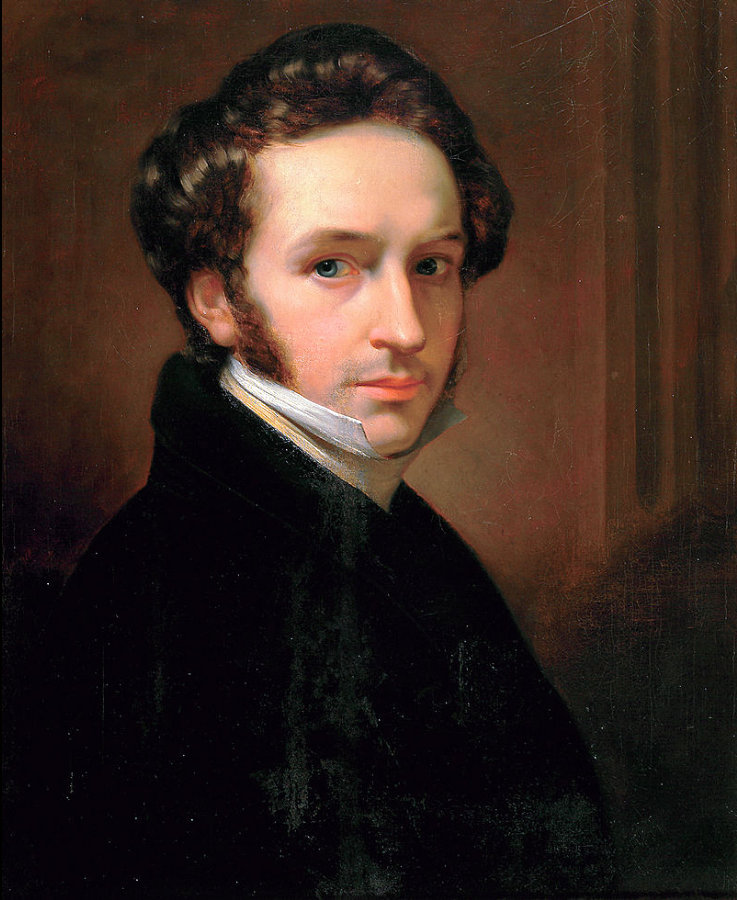Jan Adam Kruseman (Feb 12, 1804 – Mar 17, 1862), was a 19th-century portrait painter from the Northern Netherlands.
He was born to a prominent family that would produce several well-known artists. In 1819, at the age of fifteen, he went to Amsterdam, and enrolled at the Tekenacademie, where he received his first lessons from his cousin, Cornelis Kruseman. From 1822 to 1824 he studied in Brussels with François-Joseph Navez and Jacques-Louis David.
At the age of twenty-six, in 1830, he became Director of the Academy of Fine Arts (precursor to the Rijksakademie). Three years later, after doing a portrait of Adriaan van der Hoop, a banker with connections to the Royal Family, he received a commission to paint a posthumous portrait of Tsar Alexander I, intended as a gift for Anna Pavlovna, who was married to Crown Prince William. After William ascended to the throne, Kruseman was commissioned to paint official portraits of the Royal Family, including six of the King.
In 1839, along with André-Benoit Taurel (1794-1859) and Marinus Tétar van Elven (1803-1883), he became one of the founders of Arti et Amicitiae. In 1844, he was named a Ridder in the Order of the Netherlands Lion.
He was married in 1826 and had seven children, including Jan Theodoor Kruseman, who became a noted landscape painter. In 1836, his nephew, the future theologian and poet Petrus Augustus de Génestet, came to live with his family after being orphaned.
He created over 500 portraits, mostly of the nobility and wealthy burghers. His portraits are notable for their lack of idealization and attention to details of clothing. He had numerous successful students; among the best-known were David Bles, Moritz Calisch and Jozef Israëls.
After his death, he was largely forgotten although, in the 1960s, a street in Rosmalen was named after him. From 2002 to 2003, a major retrospective was held at the Het Loo Palace and, in 2015, an exhibition featuring all the artists of the extended Kruseman family was held at the Stedelijk Museum Alkmaar.
Jan Adam Kruseman received his first drawing lessons in his birthplace, but in 1819 he left for Amsterdam as a 15-year-old, where he enlisted as a member of the Drawing Academy and received a lesson from his seven-year-old pastor, the well-known painter Cornelis Kruseman (1797 -1857). Between 1822 and 1824, he continued in Brussels under the leadership of François-Joseph Navez (1787-1869) and Jacques Louis David (1748-1825).
Work:
Jan Adam Kruseman was a versatile painter of both historical and religious pieces, but he has become famous for his portraits. Among the total of 588 works of his hand are about 500 portraits, mainly of the nobility and the good fortune, including the portrait of Alida Christina Assink (1833). He has also made some portraits of the royal family. His contact with the royal house came into being in 1833, by painting a (posthumously) portrait of the Alexander Tsz of Russia, who died in 1825, on behalf of Adriaan van der Hoop (1778-1854). The painting was intended for Anna Paulowna, wife of then Crown Prince William II and Alexander I. I was able to paint both King Willem I and his son in 1837. When Willem II became king in 1840, after King’s throne, King Kruseman immediately received a government portrait. There should be at least six further portraits. What is particularly evident in the portraits is how clearly the satisfaction and self-esteem of the people has been expressed and how the clothing is shown to the smallest detail.
Social role:
Jan Adam Kruseman became a member of the Royal Academy of Fine Arts in Amsterdam on November 19, 1830, for only 26 years. In 1839 he belonged to the co-founders of the artist association Arti et Amicitiae, together with A.B.B. Taurel and M.G. Tetar of Elven. In addition, he was a member of a large number of associations and societies. At least 44 students have been in training between 1826 and 1848, including Joseph Israel. In 1844 he was appointed Knight in the Order of the Dutch Lion. In the 1960s, in the district of Hintham Zuid of Rosmalen, the municipality of Rosmalen (since 1996 part of the municipality of Hertogenbosch) was named Jan Krusemanstraat.
Exhibition:
Under the title Jan Adam Kruseman 1804 – 1862. The socialist painter of Dutch Romanticism held an exhibition in the Palace of the Loo National Museum, Apeldoorn, from October 4, 2002 to January 26, 2003.
In the Jan Cunen Museum in Oss, from 14 December 2014 until 15 March 2015, an exhibition was dedicated to counting from the painter’s genus Kruseman. The exhibition was titled Art Brothers of Romance. From 18 April 2015 until 2 August 2015 this exhibition was continued in the Stedelijk Museum of Alkmaar.
